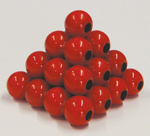|
||||||||||||||||
|
||||||||||||||||
%
responses 2009 ('05) |
||||||||||||||||
y4 |
y8 |
|||||||||||||||
| 1. How many balls make up the pyramid? | 30 | 54 (63) | ||||||||||||||
| 2. How many balls are hidden in the middle? | 1 | 25 (25) | ||||||||||||||
| 3. If another layer is added to the bottom of the pyramid, how many more balls would be needed to make the new layer? | 25 | 37 (41) | ||||||||||||||
| 4. Describe how you got that answer. | ||||||||||||||||
| clear explanation with 5 × 5 calculation | 32 (27) | |||||||||||||||
| clear explanation of thinking process | 3 (9) | |||||||||||||||
| some explanation but not clear | 4 (5) | |||||||||||||||
Total
score: |
4
|
24 (24) | ||||||||||||||
| 3
|
9 (11) | |||||||||||||||
| 2
|
3 (5) | |||||||||||||||
| 1
|
28 (29) | |||||||||||||||
| 0 | 36
(31) |
|||||||||||||||
| Subgroup Analysis [Click on charts to enlarge] : |
| Commentary: |
| The
instruction for question 2 was interpreted in various ways by students
so the results for that question were not included in the total score.
Performance was similar in 2005 and 2009. |

